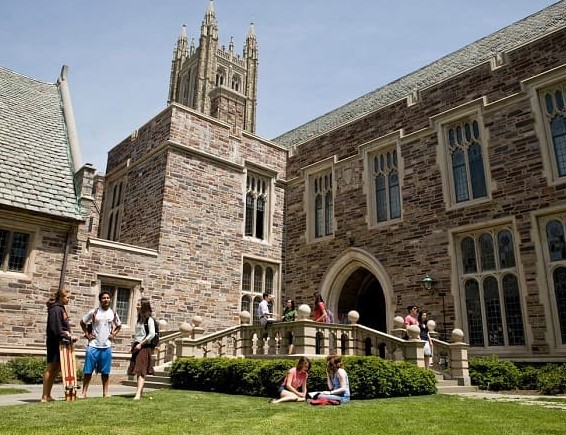Ivy League refers to the eight prestigious research institutions that make up the Ivy League conference – Harvard, Yale, UPenn, Princeton, Columbia, Brown, Dartmouth, and Cornell. These eight colleges are noted for academic distinction and great selectivity in their admissions.
So, “Why are they named the Ivy League?
” Actually, they actually received their name from a ritual known as planting the ivy! Take a trip back in time with us to discover out the history of the Ivy League, some specifics behind the moniker “Ivy League school”, and what schools and institutions make up the organisation now.
Why Are the Ivy League Colleges Named the “Ivy League?”
The “ivy” relationship with the institutions presumably arose in 1933 when the phrase was coined by Stanley Woodward writing in the New York Tribune: “A percentage of our eastern ivy universities are meeting tiny guys another Saturday before diving into the fight and the turmoil.”
This remark was in reference to the football season — the institutions, including Harvard, Princeton, Columbia, Yale, the United States Military Academy, and the United States Naval Academy had already established long standing traditions in their contests.
In 1935, the name “Ivy League” would especially be utilised by The Christian Science Monitor. The word would be synonymous with “older colleges.”
Throughout 1936, the initial Ivy League institutions would get together in an effort to retain similar interests when it came to athletics and in 1945, the first eight members would sign the Ivy Group Agreement. This defined requirements for the football teams and, in subsequent years, it would relate to other sports. The League would be formally created in 1954, with the inaugural year of competition in 1956.
So Why Did Woodward Name Them “Ivy Colleges?”
Woodward most likely adopted the name “ivy colleges” for the future Ivy League schools because of the habit of “planting the ivy!”
There were customs in the 1800’s when the students would grow ivy around the school. Penn, for example, planted ivy at every building in the spring and the day was known as “Ivy Day.” A lot of these universities had the same customs! It includes other colleges that are not designated “Ivy League schools” today.
What About the “IV League?”
There is one misconception that seems to be propagated when it comes to the Ivy League school name and that is that it stems from the Roman number for four. This story is constructed from the concept that the sports league initially had four members. Although this is a fascinating notion, there is no clear confirmation that this is where the name comes from.
Who Are the Ivy League Colleges Today?
There are eight Ivy League colleges now. They are consistently rated among the top 50 schools in the US and all offer great programmes, resources, and opportunities for their students. Presently, the Ivy Leagues are:
Harvard University
Situated in Cambridge, Massachusetts, Harvard University was formerly known as Harvard College, called so for clergyman John Harvard. It was created in 1636, offered its first lessons in 1642, and chartered in 1650.
Yale University
Yale University was initially known as the Collegiate School and was established to train Calvinist Congregational preachers. They solely taught religion and holy languages at first. It was formed and chartered in 1701. This Ivy League school may be located in New Haven, Connecticut.
Princeton University
Princeton University, formerly known as the College of New Jersey and located in Princeton, was founded and chartered in 1746. The first classes would be provided the following year. They would earn their present moniker in 1896.
University of Pennsylvania
Commonly known as Penn or UPenn, this Ivy League school was founded under the name College of Philadelphia in 1740 by Benjamin Franklin. The early courses given by the institution were not centred on the clergy, but instead focused on broad higher education. It would be called University of Pennsylvania in 1791.
Columbia University
Columbia University is located in New York City. Formerly called the King’s College, the institution was founded and licenced in 1754, with the first courses commencing the same year. The Ivy League school would become Columbia College in 1784 and Columbia University in 1896.
Brown University
Situated in Providence, Rhode Island, Brown University was formerly known as the College in the English Colony of Rhode Island and Providence Plantations or Rhode Island College. The future Ivy League school was founded in 1764. Furthermore, despite its inception was by Baptists, it was really the first institution on the continent that allowed students regardless of their religious background.
Dartmouth College
Dartmouth College, in Hanover, New Hampshire, founded in 1769, originally opened to teach Native Americans about Christian doctrine and English ways of life in an effort to transform them into missionaries. The school altered over the years before obtaining a significant renovation in the start of the 20th century and became globally recognised.
Cornell University
Located in Ithaca, New York, Cornell University was formed in 1865 by Ezra Cornell and Andrew Dickson White. With courses began in 1868, the Ivy League institution concentrated on all fields of study from day one. Currently the institution also has satellite campuses in New York City and Qatar.
Every Ivy League institution has an extraordinarily unique and rich past. Interested in attending any of these schools? We highly encourage checking into their intriguing pasts before you apply!
Do you know what the Ivy League colleges look for out of applicants? Each one is very selective, so it’s crucial that you have a game plan and know what to anticipate. With our College Match tool, you may find out which universities or colleges best match you – including, hopefully, these Ivy League schools!

